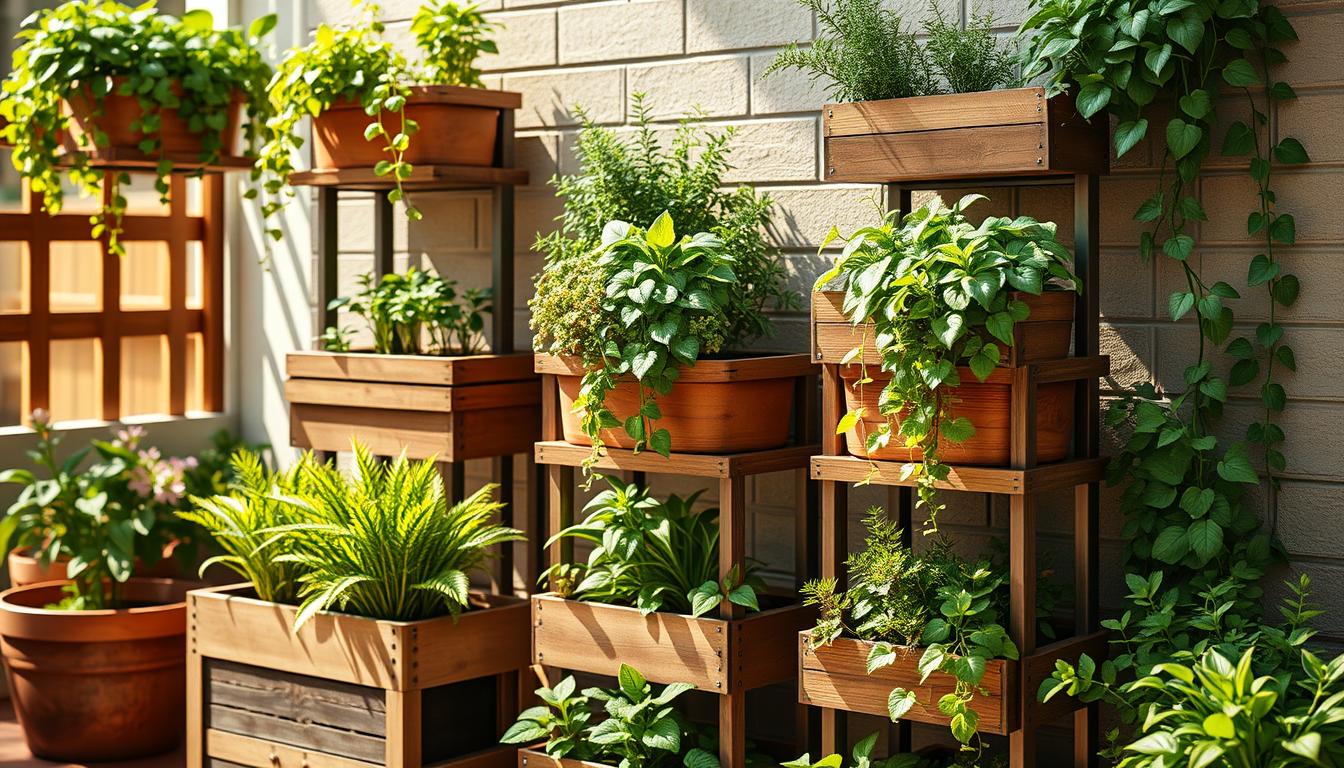Living in the city often means using every inch of space. As people move to cities and downsize, finding room for gardens is tough. Vertical gardening is a smart way to garden in small spaces.
By growing plants up instead of out, anyone can garden, no matter where they live. You can use stackable planters on a tiny balcony, small patio, or even a sunny windowsill. They let you grow herbs, flowers, and veggies in tight spots.
These planters do more than save space. They make dull walls look good, create privacy, and clean the air in busy cities. Many apartment folks turn plain areas into green oases with them.
Stackable planters are not just pretty. They’re also practical. They’re easy to reach for those with mobility issues, make watering simple, and get plants more sunlight. Whether you’re new to gardening or have been doing it for years, vertical gardening is a fun and rewarding way to grow plants.
The Growing Challenge of Limited Garden Space
Today, city dwellers face a big challenge. They want to garden but have little outdoor space. The dream of a big backyard garden is hard to keep alive as living spaces change.
Recent trends show our outdoor spaces have shrunk by nearly 40% in 20 years. This change reflects our lifestyle shifts.
More Americans live in cities now, with 82% in urban areas. Apartment living is on the rise, with many having small balconies or tiny patios.
Urban Living and the Shrinking Outdoor Space
Compact living is becoming more common. New apartments in big cities often have small balconies, just big enough for a chair and table. Yet, people still want to garden.
Real estate developers see this need. 67% of new homebuyers want outdoor space for plants, even in smaller homes. This has led to new ideas in space-saving planters.
The Psychological Benefits of Growing Plants
People want to garden because it connects them to nature. Studies show gardening can lower stress by up to 21%. It’s a big stress relief.
Gardening also boosts mood and brain function. A University of Michigan study found that 20 minutes with plants can improve memory and focus by 15-20%.
These benefits show why urban gardening is important for our health. Even without big gardens, we can still connect with nature. That’s why space-saving planters are key for modern living.
What Are Stackable Planters and Why They Matter
In urban gardening, stackable planters are a game-changer. They turn small spaces into lush gardens. These systems let you grow more plants in less space by using vertical space.
They’re a smart twist on traditional gardening. They make the most of every inch.
Definition and Basic Concepts
Stackable planters are special containers that stack up. They create a tower for plants, saving space. They’re perfect for small areas like balconies and patios.
These planters focus on a few key things. They need to be stable and not leak water. They also must be easy to reach each plant.
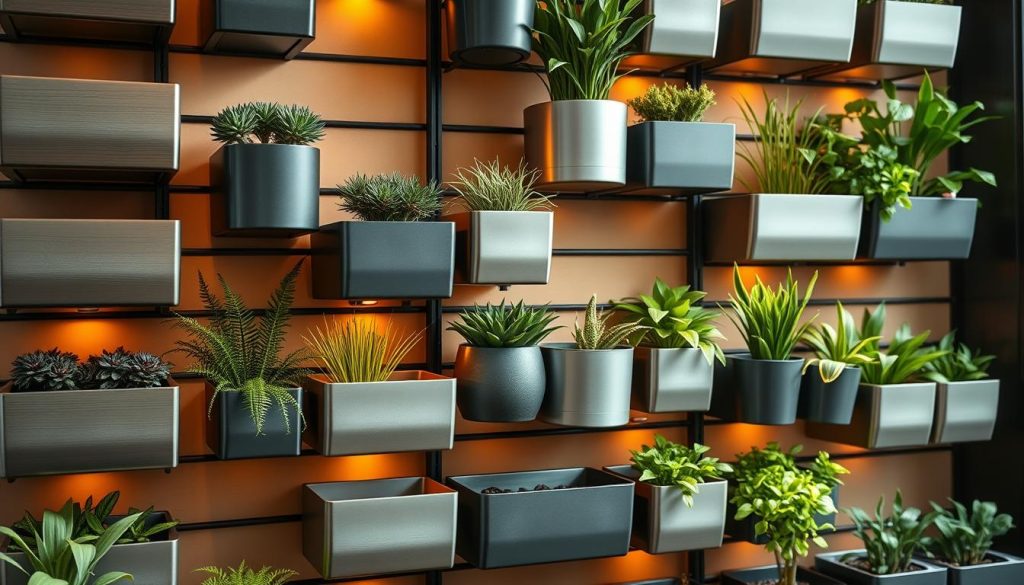
They have special locks that hold them together. This keeps them steady against wind or accidental knocks. You can also change them up as your garden grows.
Evolution of Vertical Gardening Solutions
Vertical gardening has come a long way. It started with simple ideas and grew into advanced designs. These designs tackle the challenges of growing plants up.
From Traditional Containers to Modern Systems
Early tries at vertical gardening were basic. They used standard pots or makeshift shelves. These setups were unstable and often messy.
The first stackable planters were simple but had problems. They didn’t handle water well and were hard to maintain.
Now, we have planters that solve these issues. They have special water channels and are easy to use. You can even change them to fit your space.
Technological Advancements in Planter Design
New tech has made stackable planters better. They use strong, light materials that last outside. These materials are also easy to move.
Water management has improved a lot. Modern planters have built-in water systems. They make sure plants get the right amount of water without wasting it.
| Feature | Traditional Container Gardening | Modern Stackable Planters | Benefit |
|---|---|---|---|
| Space Efficiency | Requires large horizontal area | Utilizes vertical space | Up to 4x more plants in same footprint |
| Water Management | Individual watering needed | Integrated irrigation systems | Reduced water usage, more consistent moisture |
| Mobility | Heavy, difficult to relocate | Modular, can be disassembled | Easily adapted to seasonal changes |
| Customization | Fixed size and configuration | Expandable with additional modules | Grows with gardening experience and needs |
New connections make these planters easy to use. They don’t need tools or complicated steps. This makes gardening fun for everyone.
These changes have made stackable planters popular. They help gardeners use space well and enjoy their hobby more.
The Advantages of Stackable Planters for Small Spaces
For those living in cities or with small gardens, stackable planters are a game-changer. They turn small areas into lush green spots. These planters solve the problem of limited space and add beauty and function that regular pots can’t match.
Maximizing Vertical Space
Stackable planters use space up and down, not just side to side. A small area can hold many more plants than traditional pots. For example, a 2×2 foot space can grow 12-15 plants vertically.
This way, a small balcony can grow up to 9 square feet of plants, using only 3 square feet of space. It’s a 300% increase in space for plants.
In cities, these planters are super useful. Even with just a window sill or tiny balcony, you can grow many plants. Vertical gardening makes it possible where regular pots can’t.
Flexibility and Adaptability
Stackable planters are very flexible. You can change them as your garden grows or needs change. They’re easy to add to or take away from.
They also adjust with the seasons. In summer, use all the tiers for more plants. In winter, take some down for a smaller setup indoors.
These planters are also easy to move. You can change where your garden is to follow the sun or for parties. This keeps your garden looking great without being stuck in one place.
Aesthetic Appeal in Limited Areas
Stackable planters also make small spaces look better. They make the area seem bigger by going up instead of out. This adds depth and makes the space feel more open.
Creating Visual Interest with Height Variation
The different heights of these planters add interest. They look like a natural forest or meadow. This makes your garden feel more natural and beautiful.
By placing taller plants up and trailing ones down, you create a lively display. It looks like you planned it, not just threw plants together. This makes small spaces feel bigger and more put together.
Color and Texture Coordination
Stackable planters are great for mixing colors and textures. You can use different plants to create a beautiful look. For example, mix ferns with broad-leafed plants and vines.
Colors work better in vertical gardens. Try a color gradient or a single color theme. This can match your furniture or decor inside or outside.
These planters are more than just space savers. They become beautiful parts of your garden. They make small spaces feel like a big, immersive garden experience.
Types of Stackable Planters for Different Needs
The market offers many stackable planters for various gardening needs. Whether you have a small balcony or an apartment, there’s a planter for you. Knowing the strengths and limits of each type helps you choose wisely.
Modular Stacking Systems
Modular planters are all about customization. They have interlocking parts that can be set up in many ways. Each pot connects through special locks, letting you grow more as you need.
Prices for modular planters range from $30 to $100. They’re great for those who like to change their garden or start small. You can easily change their layout with the seasons or as your plants grow.
Tiered Planters
Tiered planters have a stepped design that looks good and works well. They have 3-5 levels, with each one smaller than the last. This creates a beautiful, cascading effect.
Costing between $25 and $75, tiered planters are perfect for small spaces. They’re great for growing strawberries, herbs, and flowers that spill over the edges.
Vertical Wall Planters
Wall planters turn blank walls into gardens. They attach to walls, fences, or railings. Most have pockets, shelves, or containers arranged in a grid.
Prices for wall planters range from $20 to $150. They’re ideal for tiny spaces or to create living art. They’re good for herbs, succulents, and small flowers, but need more water.
Self-Watering Stackable Options
Self-watering planters are a big step forward in gardening. They have water reservoirs and systems that make watering easier. This helps keep plants healthy.
GreenStalk Vertical Garden System
The GreenStalk system has a central water column that waters all pockets evenly. It can hold up to 30 plants in a small space. It’s made in America and costs $150 to $200. It’s great for vegetables and herbs.
Mr. Stacky Smart Farm
Mr. Stacky’s hydroponic system is a smart choice. It costs $100 to $130 and has a 5-tier tower with a pump and timer. It’s perfect for growing leafy greens and herbs indoors.
Ideal Plants for Stackable Planter Systems
Choosing the right plants for stackable planters is key to success. These planters have unique growing conditions. Plants need to adapt to small soil, uneven watering, and changing light.
By picking the right plants, your stackable garden will stay vibrant and productive all season.
Herbs and Small Vegetables
Herbs and small vegetables are great for stackable planters. They have small root systems and grow well in tight spaces. Many herbs taste better when their roots are a bit cramped.
Basil, Thyme, and Compact Tomato Varieties
Basil types like ‘Spicy Globe’ and ‘Greek Dwarf’ stay bushy and don’t grow too tall. Thyme, like lemon and creeping types, spreads out rather than up. For tomatoes, look for ‘Tiny Tim’ or ‘Patio Princess’ varieties. They grow to a set height and produce fruit without overwhelming your system.
When planting tomatoes, put them in the top tier so they don’t shade other plants. They need at least 8-10 inches of soil to grow well and produce fruit.
Flowering Plants and Succulents
Flowering plants and succulents add color and interest to stackable systems. They thrive in the challenging conditions of vertical gardens.
Compact marigolds, pansies, and zinnias do well in stackable gardens. Their shallow roots and plenty of blooms are perfect for middle tiers. Succulents like Echeveria, Sedum, and Haworthia need little soil and water, making them great for drier tiers.
Cascading Plants for Visual Impact
Cascading plants create stunning effects in stackable planters. They spill over the edges, adding depth and movement to your garden.
Trailing Petunias and Ivy Varieties
Wave petunias can trail up to 4 feet, making a colorful cascade. English ivy and Swedish ivy provide greenery all year. For something edible, try trailing rosemary or creeping thyme. They’re beautiful and useful in the kitchen.
| Plant Type | Ideal Tier Placement | Root Depth Needed | Watering Frequency | Companion Compatibility |
|---|---|---|---|---|
| Compact Herbs | Any tier | 4-6 inches | Moderate | High with most plants |
| Dwarf Vegetables | Top/middle tiers | 8-12 inches | High | Best with similar water needs |
| Flowering Annuals | Middle tiers | 6-8 inches | Moderate to high | Medium compatibility |
| Succulents | Any tier with sun | 3-4 inches | Low | Best with other succulents |
| Trailing Varieties | Upper tiers | 4-8 inches | Varies by species | High visual impact with all types |
Setting Up Your First Stackable Planter Garden
Starting your first stackable planter garden needs careful planning. It’s not just about stacking containers. You must think about several important factors for your plants’ health and growth. Let’s look at the key steps to create a thriving vertical garden that uses your space well.
Location Considerations
Choosing the right spot for your planters is key. Look at the space you have—like a balcony, patio, or small yard corner. Think about how easy it is to get to for watering and maintenance. Also, make sure it’s safe from strong winds that could knock over tall setups.
The weight of your setup is also important. Make sure the spot can handle the weight of the containers, soil, plants, and water. For balconies or decks, check if they can hold the weight of your setup.
Light Requirements and Exposure Analysis
Knowing about sunlight is crucial for picking plants. Do a light analysis by watching your spot throughout the day. Note how much direct sunlight it gets and when it’s shaded.
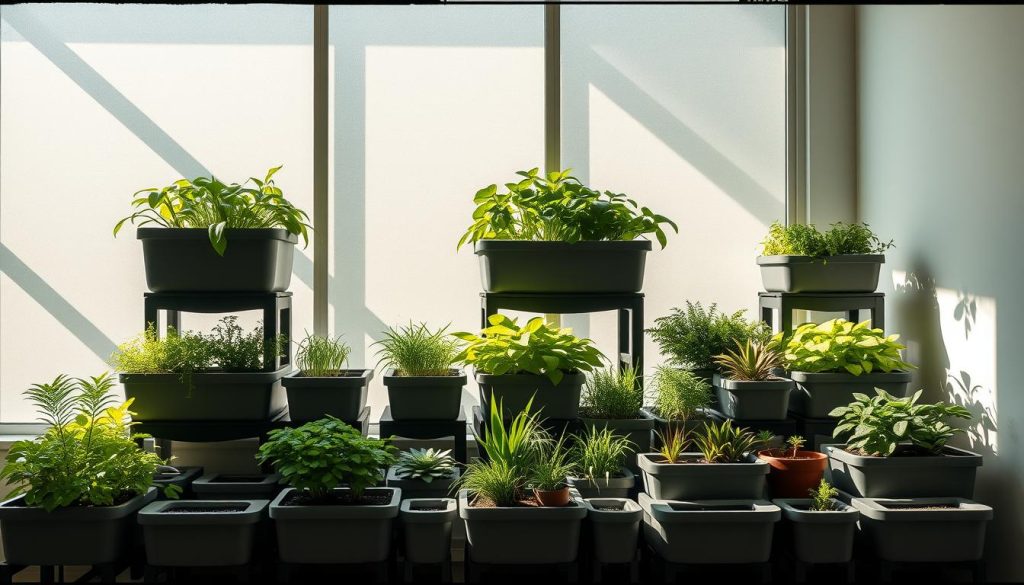
Make a simple tracking sheet to check sunlight every hour. This helps you pick the right plants for each level. Put sun-loving plants at the top and those that like shade at the bottom.
| Time of Day | Light Condition | Best Plants | Planter Position |
|---|---|---|---|
| Morning (6-10am) | Gentle direct sun | Herbs, leafy greens | East-facing levels |
| Midday (10am-2pm) | Intense direct sun | Tomatoes, peppers | Top levels |
| Afternoon (2-6pm) | Strong direct sun | Succulents, drought-tolerant | West-facing levels |
| Evening (6pm+) | Indirect/shade | Ferns, impatiens | Lower/shaded levels |
Soil and Drainage Requirements
Stackable planters need special soil. Use a lightweight, well-draining potting mix made for containers. This mix prevents waterlogging and supports root growth.
Add perlite or vermiculite to improve drainage. Use coconut coir or compost for moisture retention. Different plants need different soil types.
Assembly Tips and Tricks
Start with a solid, level base when assembling your system. Place the biggest container at the bottom and add smaller ones above. Make sure each level is stable before adding soil and plants.
Make drainage paths by aligning holes or adding small stones at the bottom. This stops water from pooling and causing root rot. For stability in tall setups, slightly offset each level.
When adding new sections, be careful not to disturb plants. It’s better to plan everything from the start. If you must add levels, do it slowly, letting plants adjust to changes.
Maintenance and Care for Stackable Planters
Stackable planter systems need special care to keep plants healthy and the structure strong. These vertical gardens save space but have unique care needs. Knowing these will help your plants do well in their vertical home.
Watering Challenges and Solutions
Vertical gardens face moisture issues. The top gets dry fast from sun and wind, while the bottom stays wet. This is because of uneven moisture.
To solve this, use a drip irrigation system. It gives steady water to each level. Self-watering planters also help by keeping moisture even.
For the top, add coconut coir or hydrogels to keep it moist. Make sure the bottom has good drainage. Add gravel to stop water from pooling.
Fertilizing Strategies
Slow-Release vs. Liquid Fertilizers
Choosing the right fertilizer is key for stackable systems. Slow-release fertilizers are easy and feed plants over months. They’re great for those who don’t have much time.
Liquid fertilizers give quick nutrients and let you control feeding. They’re good for when plants need extra food or during busy growing times. For vertical gardens, use liquid fertilizers at half strength and more often.
Seasonal Maintenance
Check your system often to keep plants and structure in good shape. In spring, check connections and supports before adding new plants. Summer is for watching out for pests, as they can spread fast.
Fall is for pruning and removing old plants. Winter is for protecting against cold damage. To keep your garden productive all year, change crops with the seasons and refresh the soil yearly.
Creative Uses for Stackable Planters Beyond Traditional Gardening
Stackable planters are more than just for gardening. They can turn any space into a stylish and functional area. They’re perfect for adding greenery in new ways, improving your home’s look, or creating cozy spots.
Indoor Living Walls
Living wall planters are a cool way to use vertical gardening. They turn plain walls into beautiful, living walls that clean the air and look great.
Lighting is key for indoor living walls. Use grow lights for plants that don’t get enough natural light. Choose plants like pothos, ferns, and peace lilies for their air-purifying benefits.
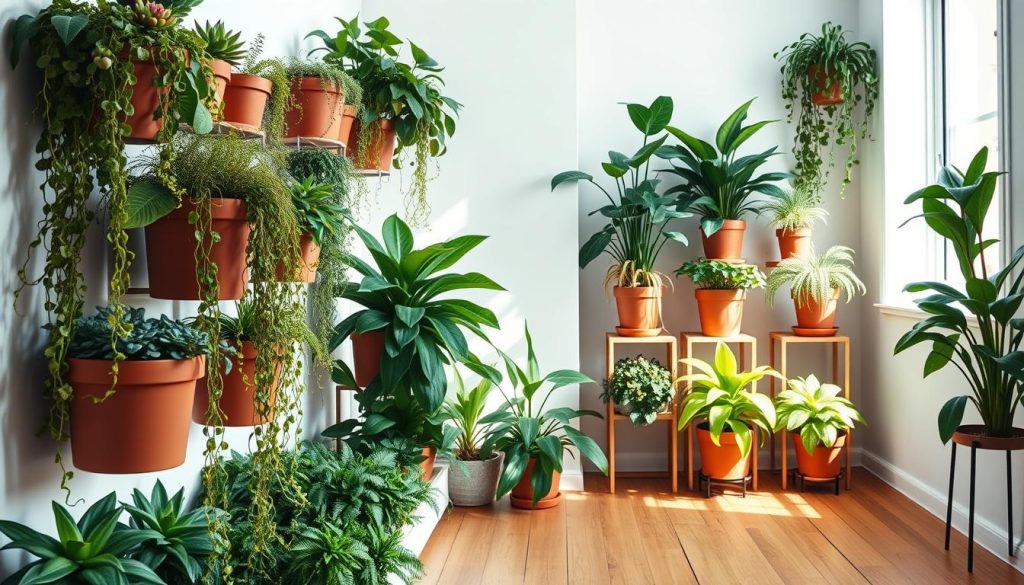
Sarah from Portland says, “My living wall is the highlight of my home office. It’s also made the air cleaner. Clients always comment on how beautiful it is.”
Herb Kitchen Gardens
Stackable planters are great for growing herbs. Place them near your kitchen to always have fresh ingredients.
Plan your herb layout carefully. Put basil and parsley where you can easily reach them. Use lower levels for plants like rosemary and thyme.
Chef Michael says, “Having my herbs in a vertical garden has changed my cooking. The freshness is amazing, and it saves space.”
Decorative Room Dividers
Stackable planters are also great for dividing rooms. They let air and light flow while adding color and texture.
In open-concept homes, a vertical garden can make different areas without losing the open feel. Mix plants of different heights and textures for interest.
Privacy Solutions for Balconies and Patios
Urban folks love stackable planters for privacy. They block views and create a cozy spot.
For best privacy, mix fast-growing climbers with bushy plants. This creates a natural barrier that makes your outdoor space better.
| Creative Use | Best Plant Types | Key Benefits | Maintenance Level |
|---|---|---|---|
| Indoor Living Walls | Pothos, Ferns, Peace Lilies | Air Purification, Visual Impact | Medium |
| Kitchen Herb Gardens | Basil, Parsley, Mint, Thyme | Fresh Cooking Ingredients, Aroma | Low-Medium |
| Room Dividers | Snake Plants, Spider Plants | Space Definition, Aesthetic Appeal | Low |
| Privacy Screens | Ivy, Jasmine, Bamboo | Sightline Blocking, Natural Barrier | Medium-High |
Overcoming Common Challenges with Stackable Planters
Stackable planters are great for gardens, but they come with challenges. Knowing these challenges can help your garden grow well. With the right planning, you can solve common problems with stackable planters.
Weight and Stability Issues
As you add more planters, keeping them stable is key. Heavy plants can make them tip over, even in the wind.
Start with a wide base for stability. For tall setups, tie the bottom to a wall. This is crucial for windy spots like balconies.
Choose heavy materials for better stability. Lighter planters need extra weight at the bottom for balance.
Uneven Watering Problems
Getting water right in vertical gardens is hard. Top planters dry out fast, while bottoms stay wet.
Use different soils for each level. Add water-holding materials to tops and drainage to bottoms. This balances moisture.
Watch for signs of too much or too little water. Yellow leaves mean too wet, while dry tips mean too dry. Adjust your watering to fix this.
Plant Competition for Light
In vertical gardens, big plants can block light. This makes smaller plants weak and stretched out.
Place sun-loving plants at the top. Use middle and lower tiers for plants that don’t need much light.
Prune plants to control light. Cut back big plants to let others get more sun. Direct cascading plants outward to avoid shading.
Strategic Placement for Optimal Growth
The spot you place your planters affects growth. South-facing spots get lots of light but can be too hot.
Rotate your planters for even light. Use grow lights indoors to help plants grow well.
Don’t stick to one column. Arrange planters in steps for better light and space-saving benefits.
DIY Stackable Planter Projects for the Budget-Conscious
For those on a budget, DIY stackable planters are a smart choice. They save money and let you tailor your garden to your taste. You can make a vertical garden for less than buying one.
Upcycled Container Ideas
Turning old items into planters is good for the planet and your wallet. Look around your house for things you can reuse instead of buying new.
Repurposing Plastic Bottles and Buckets
Plastic bottles can become mini-planters when cut in half and stacked. Cut the bottom third off a 2-liter bottle, add drainage holes, and use the top as a water reservoir for the plant below.
Five-gallon buckets can also be turned into big planters. Cut windows for plants, add drainage holes, and use dowels or PVC for support.
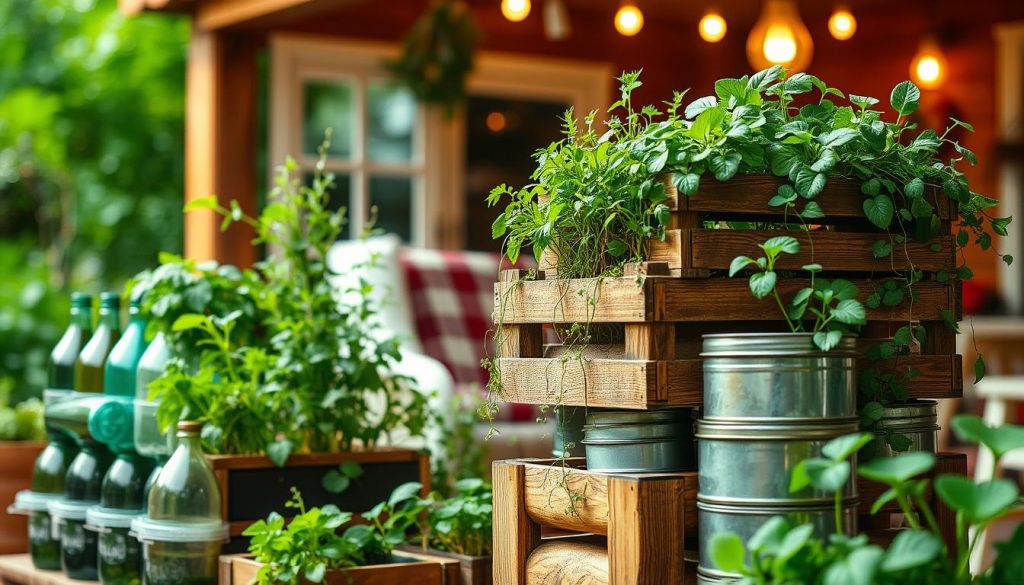
Simple Construction Projects
You can build strong planters with basic tools. A tiered planter from scrap wood needs a saw, drill, and screws. Make three boxes, attach them, and you’re ready for plants.
PVC pipe gardens are easy to make. Cut 4-inch PVC into 8-inch pieces, drill holes, cap the ends, and stack them for a vertical garden.
Cost-Effective Materials
Choose materials wisely for your DIY planters. Untreated pine is cheap but may need replacing in 2-3 years. Cedar is pricier but lasts 10+ years without treatment.
Upcycled plastic containers are almost free but may fade in sunlight. Painting them can make them last longer and look better.
Seasonal Strategies for Year-Round Stackable Planter Gardening
Adjusting your stackable planter garden for each season keeps your harvests going all year. These systems can handle any climate, making them great for gardeners who keep growing no matter the weather.
Spring and Summer Planting Plans
Spring and summer are the best times for your stackable garden. You can start new seeds every few weeks for a steady supply of fresh produce.
Stackable gardens get more sunlight than regular gardens. To avoid overheating in summer, try these tips:
- Place taller plants to shade smaller ones
- Put up shade cloth on the sunniest side
- Water more often, best in the morning
- Use light-colored planters to reflect heat
Fall and Winter Adaptations
When it gets colder, switch to plants like kale and spinach. The vertical design of stackable planters helps protect against frost.
Keep growing by adding covers. Use row covers or small hoop structures to create mini-greenhouses that keep warm.
Indoor Transitions for Cold Climates
In very cold weather, move small stackable units inside. Check for pests and trim plants before moving them indoors.
Keep plants humid by grouping them or using pebble trays. Indoor air is often very dry, unlike outside.
Supplemental Lighting Options
Indoor gardening needs extra light. Start with basic grow bulbs for a few plants.
For serious indoor gardening, try LED grow lights. They’re energy-efficient and give plants the right light for growing.
By changing your approach with each season, stackable planters become more than just summer containers. They become a year-round way to garden, no matter the weather.
Why Stackable Planters Are the Future of Urban Gardening
As cities get more crowded and homes smaller, stackable planters are a smart choice. They let anyone grow plants, even with little space.
The growth of urban gardening is more than a trend. It’s how we adapt to our changing world. With 68% of people living in cities by 2050, we need new ways to grow food and plants.
New tech is making stackable systems better. Smart planters with sensors and apps help us care for plants easily. This makes gardening possible for those with busy lives.
Living wall planters and vertical gardens save space and bring people together. They create shared spaces for neighbors to grow food and connect.
These planters also boost our mental health. Studies show plants reduce stress and anxiety. They help us stay connected to nature in the city.
Stackable planters are a small but important step towards living sustainably. They let anyone grow plants, even without a backyard. It’s a way for city folks to contribute to the environment.

